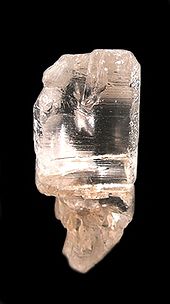This is an old revision of this page, as edited by George H. Edwards (talk | contribs) at 00:44, 7 January 2013 (→References). The present address (URL) is a permanent link to this revision, which may differ significantly from the current revision.
Revision as of 00:44, 7 January 2013 by George H. Edwards (talk | contribs) (→References)(diff) ← Previous revision | Latest revision (diff) | Newer revision → (diff)| Petalite | |
|---|---|
 Petalite from Minas Gerais State, Brazil (size: 3x4 cm) Petalite from Minas Gerais State, Brazil (size: 3x4 cm) | |
| General | |
| Category | Tectosilicate |
| Formula (repeating unit) | LiAlSi4O10 |
| Strunz classification | 09.EF.05 |
| Crystal system | Monoclinic |
| Space group | Monoclinic prismatic H-M symbol: (2/m) Space group: P 2/a |
| Unit cell | a = 11.737 Å, b = 5.171 Å, c = 7.63 Å; β = 112.54°; Z = 2 |
| Identification | |
| Color | Colorless, grey, yellow, pink, to white |
| Crystal habit | Tabular prismatic crystals and columnar masses |
| Twinning | Common on {001}, lamellar |
| Cleavage | Perfect on {001}, poor on {201} with 38.5° angle between the two |
| Fracture | Subconchoidal |
| Tenacity | Brittle |
| Mohs scale hardness | 6 - 6.5 |
| Luster | Vitreous, pearly on cleavages |
| Streak | Colorless |
| Diaphaneity | Transparent to translucent |
| Specific gravity | 2.4 |
| Optical properties | Biaxial (+) |
| Refractive index | nα=1.504, nβ=1.510, nγ=1.516 |
| Birefringence | δ = 0.012 |
| 2V angle | 82 – 84° measured |
| Melting point | 1350 °C |
| Fusibility | 5 |
| Solubility | Insoluble |
| References | |
Petalite, also known as castorite, is a lithium aluminium tectosilicate mineral LiAlSi4O10, crystallizing in the monoclinic system. Petalite is a member of the feldspathoid group. It occurs as colourless, grey, yellow, yellow grey, to white tabular crystals and columnar masses. Occurs in lithium-bearing pegmatites with spodumene, lepidolite, and tourmaline. Petalite is an important ore of lithium, and is converted to spodumene and quartz by heating to ~500 °C and under 3 kbar of pressure in the presence of a dense hydrous alkali borosilicate fluid with a minor carbonate component. The colorless varieties are often used as gemstones.

Discovered in 1800, type locality: Utö Island, Haninge, Stockholm, Sweden. The name is derived from Greek petalon for leaf.
References
- "Petalite". Digital Fire. Retrieved 23 October 2011.
- Handbook of Mineralogy
- Webmineral
- ^ Mindat
- *Hurlbut, Cornelius S. and Klein, Cornelis, 1985, Manual of Mineralogy, Wiley, 20th ed., pp. 459-460 ISBN 0-471-80580-7
- Framework silicates: silica minerals, feldspathoids and the zeolites (2. ed. ed.). London: Geological Soc. 2004. p. 296. ISBN 1-86239-144-0.
{{cite book}}:|edition=has extra text (help);|first=missing|last=(help)
This article about a specific silicate mineral is a stub. You can help Misplaced Pages by expanding it. |
Economic deposits of petalite are found near Calgoorlie, Western Australia, Aracuai, State of Minas Gerais, Brazil, Karibib, Namibia, Manitoba, Canada, and Bikita, Zimbabwe. The first important economic application for petalite was as a raw material for the glass-ceramic cooking ware CorningWare(c). It has been used as a raw material for ceramic glazes.
Categories: